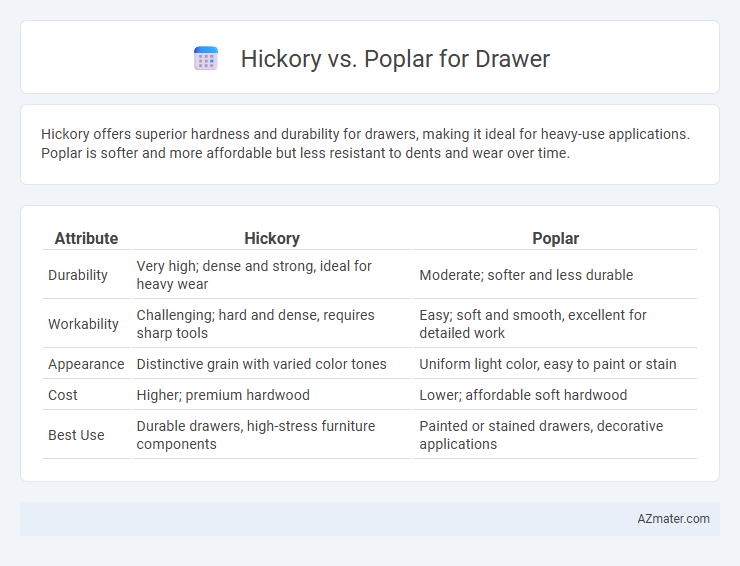Hickory offers superior hardness and durability for drawers, making it ideal for heavy-use applications. Poplar is softer and more affordable but less resistant to dents and wear over time.
Table of Comparison
| Attribute | Hickory | Poplar |
|---|---|---|
| Durability | Very high; dense and strong, ideal for heavy wear | Moderate; softer and less durable |
| Workability | Challenging; hard and dense, requires sharp tools | Easy; soft and smooth, excellent for detailed work |
| Appearance | Distinctive grain with varied color tones | Uniform light color, easy to paint or stain |
| Cost | Higher; premium hardwood | Lower; affordable soft hardwood |
| Best Use | Durable drawers, high-stress furniture components | Painted or stained drawers, decorative applications |
Introduction: Hickory vs Poplar for Drawer Construction
Hickory offers exceptional strength and durability, making it ideal for drawer construction in heavy-use furniture. Poplar is a softer hardwood, valued for its smooth finish and ease of machining, which suits less demanding drawer applications. Choosing between hickory and poplar depends on the balance between toughness required and the desired aesthetic finish.
Wood Characteristics: Hickory and Poplar Comparison
Hickory features a dense, hard grain with excellent shock resistance, making it ideal for durable drawer construction, while Poplar is a softer hardwood with a fine, even texture that offers easier workability but less wear resistance. Hickory's distinct grain patterns and varying color contribute to a rustic, robust appearance, whereas Poplar's lighter, more uniform color provides a smooth surface suited for painting and finishing. The hardness rating of Hickory on the Janka scale averages around 1820, significantly higher than Poplar's 540, underscoring Hickory's superior strength and longevity in drawer applications.
Durability and Strength Differences
Hickory is renowned for its exceptional durability and strength, making it ideal for drawer construction that demands heavy use and resistance to wear. Poplar, while easier to work with and more affordable, lacks the same density and hardness as Hickory, resulting in lower resistance to dents and scratches. Choosing Hickory ensures long-lasting, sturdy drawers, whereas Poplar suits lighter-duty drawers with less exposure to impact.
Workability and Machining Ease
Hickory offers exceptional durability but can be challenging to machine due to its density and hardness, requiring sharp tools and slower feed rates for precise shaping. Poplar is favored for its superior workability, easily cut and shaped with standard woodworking tools, making it ideal for intricate drawer components. While Poplar machines smoothly with minimal wear on tools, Hickory demands more effort but provides a sturdier finish for high-use drawer applications.
Aesthetics: Grain, Color, and Appearance
Hickory features a bold, prominent grain pattern with rich, varied hues ranging from creamy white to deep reddish-brown, providing a rustic and striking appearance ideal for statement drawer fronts. Poplar offers a more subtle, fine, and straight grain with a pale yellowish-green to light brown color, lending a smooth and uniform look that suits modern or minimalist drawer designs. Both woods can be stained or painted effectively, but Hickory's natural color and grain variations offer more visual texture, while Poplar's consistent appearance delivers a versatile, clean finish.
Cost and Availability: Hickory vs Poplar
Hickory is generally more expensive than poplar due to its hardness, durability, and limited availability, making it a premium choice for drawers. Poplar, being a softer wood, is widely available and more affordable, often preferred for budget-friendly drawer projects. Cost differences are influenced by regional availability, with hickory sourced mainly from the Appalachian region and poplar widely grown across North America.
Finishing Options and Compatibility
Hickory offers exceptional finishing options due to its dense grain and natural color variations, allowing for rich stain absorption and a smooth, durable finish ideal for drawer fronts. Poplar's softer texture and pale, uniform color make it highly compatible with paint finishes, providing a smooth surface that holds color well and resists blotching. Choosing between hickory and poplar depends on whether a natural wood stain or a vibrant painted finish is desired for drawer applications.
Environmental Impact and Sustainability
Hickory, known for its durability and strength, often comes from slow-growing trees, which can lead to longer harvest cycles impacting forest regeneration rates. Poplar grows much faster, making it a more renewable option with a smaller carbon footprint due to quicker replenishment and less resource-intensive cultivation. Choosing Poplar for drawers supports sustainable forestry practices by promoting faster growth cycles and reducing habitat disruption compared to the denser, slower-growing Hickory.
Best Applications: Where Each Wood Excels
Hickory wood excels in drawer construction where durability and resistance to wear are essential, making it ideal for heavy-use areas such as kitchen and workshop drawers due to its hardness and shock resistance. Poplar wood is best suited for painted drawer fronts and interior drawer components because of its smooth grain and ease of finishing, offering a cost-effective option for decorative applications. Choosing hickory for strength and poplar for versatility ensures optimal performance and aesthetic appeal in drawer cabinetry.
Conclusion: Choosing the Right Wood for Your Drawers
Hickory offers superior strength and durability, making it ideal for heavy-use drawers that require long-lasting performance. Poplar, being softer and easier to work with, suits decorative drawers or pieces where paint finishes are preferred. Selecting between hickory and poplar depends on balancing the need for resilience against the desired appearance and finish of your drawers.

Infographic: Hickory vs Poplar for Drawer
 azmater.com
azmater.com